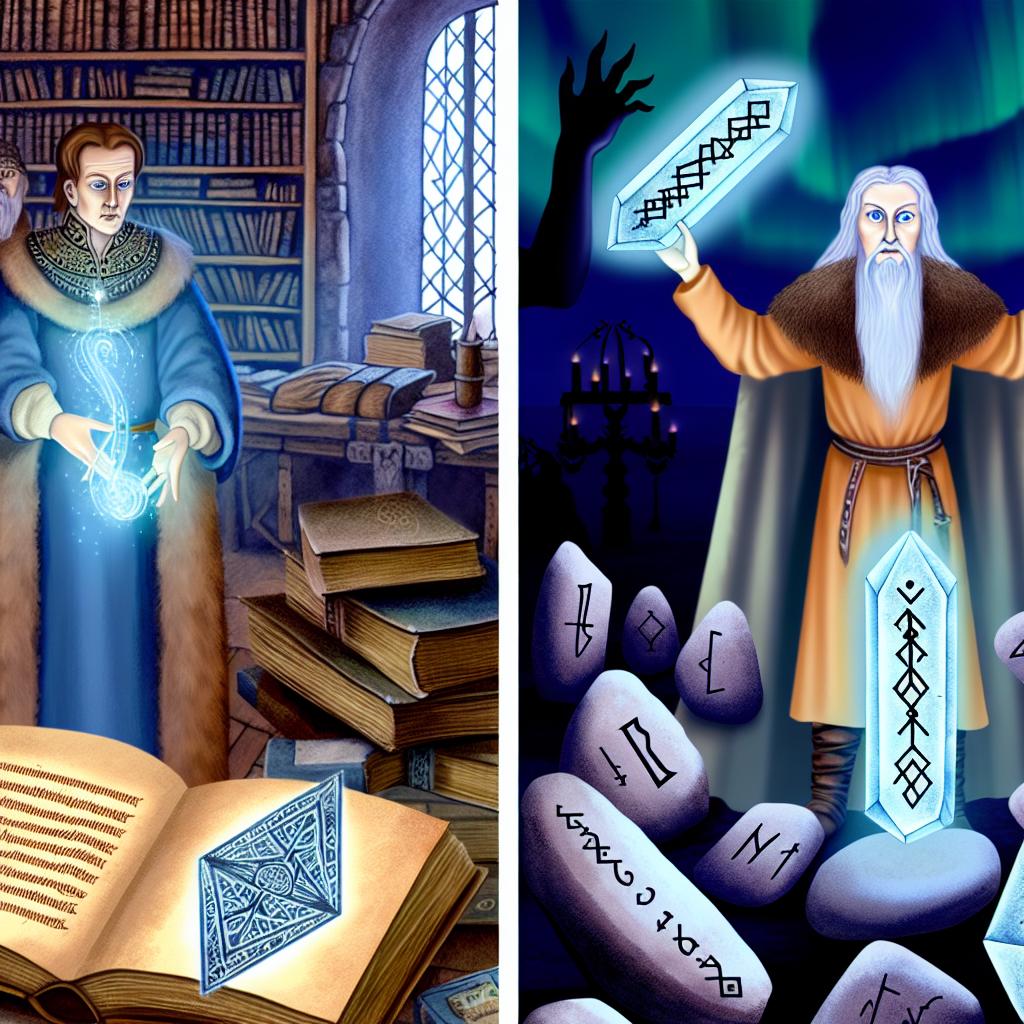Magic Wands vs. Magic Runes: A Comparison

Understanding Magic Wands and Magic Runes
Magic wands and magic runes have long captured the human imagination, representing central tools in the realm of magic, myth, and fantasy. These instruments, often depicted as harnessing mystical energies, play a pivotal role in magical practices and folklore traditions. While both are employed to channel or focus magical forces, their origins, applications, and symbolism provide distinct insights into the multifaceted nature of magic.
Origins and Historical Context
Magic Wands: The magic wand, a slender rod-like tool, has a history that stretches back to ancient civilizations. Throughout the ages, wands have been depicted and utilized in diverse magical practices. Their use is notably prevalent in European folklore, where witches and wizards are often portrayed wielding these potent tools. In some traditions, wands are carved from specific types of wood believed to contain inherent magical properties. This natural connection links wands to the wisdom of ancient times, grounding their mystical attributes in the essence of nature itself. The choice of wood, craftsmanship, and the wand’s components are all thought to contribute to its magical efficacy, each aspect resonating with mystical forces.
Magic Runes: In contrast, runes are a set of characters originating from the runic alphabets used by ancient Germanic peoples. Historically, these symbols were etched into materials like stones, wood, or metal, seen as objects bearing magical power beyond mere writing and communication. Each rune boasts a unique meaning and energy, believed to be harnessed in divination, protection spells, or ritualistic contexts. The magical use of runes is deeply intertwined with Norse mythology and the ancient cultures of Scandinavia, reflecting a profound understanding of their origins and functions. As a script and a mystical system, runes offer a multidimensional connection to cultural heritage.
Applications in Magic
Magic Wands: In practice, magic wands are primarily conduits through which a magic user directs their energy and intentions. In fictional worlds crafted by literature and cinema, wands are often instrumental in casting spells, summoning entities, or executing enchantments. The depiction of wands in these narratives emphasizes their role as pivotal magical tools, with the power of each wand often linked to the wood type, craftsmanship, and the magical core or materials incorporated into its construction. This variability highlights the personalized nature of wands, each carrying a unique signature and potential for magical work.
Magic Runes: Runes, on the other hand, offer a robust range of applications in magical practices, from divination to the casting of spells. A practitioner might inscribe or cast runes to seek insights into future events, trusting in the runes’ guidance. Runes can also be used to create protective charms or amulets, wherein a specific rune is carved or inscribed onto an object to imbue it with magical energy. The effective application of runes necessitates a profound comprehension of their individual meanings and contextual uses, with each rune’s symbolism adding depth to the practitioner’s intent and ritual outcomes.
Symbolism and Cultural Significance
Magic Wands: The symbolism of the wand is closely tied to notions of power, authority, and mastery over magical forces. A wand often represents not just a magic user’s ability but also serves as an extension of their will and skill. Across cultural narratives, the wand may reflect the social standing of a sorcerer or magician, highlighting their competence and position within a magical community. Whether in the hands of a mythical figure or a fictional character, the wand symbolizes control and command over mystical elements.
Magic Runes: Runes are steeped in symbolic significance, intertwining with both linguistic and magical traditions. Each rune embodies specific concepts such as protection, growth, or destruction, carrying forward cultural narratives from ancient myths. As potent symbols, runes serve to link practitioners to the ancestral roots and spiritual traditions of Northern European cultures. They not only provide insight into the world of the divine and the natural but also encourage a communicative connection that transcends generations, offering a path to understanding and engaging with mystical beliefs.
Conclusion
In summary, while magic wands and magic runes both hold vital roles in mystical practices across varied traditions, their distinct origins and functions highlight the diversity of magical tools and applications. Magic wands serve primarily as channels for the projection of magic, empowering users to focus and direct their intentions with clarity and precision. In contrast, magic runes provide symbolic and ritualistic functions that delve deeply into ancient traditions and cultural heritage, offering a conduit to the mystical legacies of the past.
Understanding both tools illuminates the ways in which humans have historically interpreted and interacted with the mystical elements of their world. Magic wands, born of ancient natural wisdom, reflect the individual’s connection to and command of magic through tangible artifacts of power. Meanwhile, magic runes, with their rich cultural significance, offer a bridge to the mythological and symbolic tapestry that underpins ancient belief systems. Together, these instruments underscore the profound connection between humanity and the magical realities they seek to understand and control, revealing a tapestry woven from history, culture, and fantasy.
Comments are closed.
Comments on 'Magic Wands vs. Magic Runes: A Comparison' (0)
Comments Feed